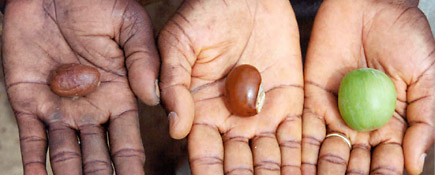The Quality of Shea Butter
There are huge differences in the quality of fats and oils. This depends partly on the quality of the starting materials and partly on the processing.

Industry has a simple solution for low-quality and cheap fats: Refining! This process frees the fats from all other substances. Dirt, bacteria, mold…a butter suitable for cosmetics (or for food) can be “refined” even from old or contaminated material. The problem, however, is that good and useful substances like vitamins, minerals, fragrance, etc. are also lost.
Our Fair-Shea butter is unrefined! That means that only the best shea nuts are used to produce it. The nuts are then processed very carefully into shea butter so that all the valuable ingredients are included! Only a very fine filtration (ultrapurification) is applied so that no unwanted impurities, microbes, oxidants, peroxides, or free fatty acids are present in our butter.
In addition, our shea butter is 100% pure. So you get nothing but shea butter. Of course, you can combine the shea butter with other materials like oils, fragrances, emulsifiers, etc. before use. You can find suggestions on the Skin and Hair pages. But you should only purchase absolutely pure shea butter, because the additives in other products ultimately serve only to dilute the high-quality and expensive shea butter through cheap admixtures.
Appearance, Smell, Taste
Unrefined shea butter has a light yellow to beige color because it contains beta carotene. It melts at 30-35˚C. If it is cooled again, it will have a characteristic crystal formation with a rough and flaky surface. Shea butter exudes a nutty-buttery or tangy scent. Even after skin application, this is noticeable for 15-20 minutes. The taste of shea butter is slightly nutty, similar to walnuts or Macadamia nuts. Since our shea butter is food grade, you can safely taste it.
Composition and Active Ingredients
 Fair-Shea butter comes from West African shea trees. All scientific studies on the ingredients of shea butter find large differences from sample to sample. The butter produced in West Africa has the best values. It’s especially valuable for cosmetics that shea butter contains more complex and unsaponifiable lipids (fats) than all other organic oils (8-17%). Since these are very similar to the oils of the skin, they can be absorbed particularly well and ensure a velvety-soft feeling.
Fair-Shea butter comes from West African shea trees. All scientific studies on the ingredients of shea butter find large differences from sample to sample. The butter produced in West Africa has the best values. It’s especially valuable for cosmetics that shea butter contains more complex and unsaponifiable lipids (fats) than all other organic oils (8-17%). Since these are very similar to the oils of the skin, they can be absorbed particularly well and ensure a velvety-soft feeling.
A further strength of shea butter is its high content of secondary ingredients: acetyl and cinnamyl triterpene are anti-inflammatory and have a positive effect on allergies. The vitamin E content (200µg / g) is especially high in our shea butter and ensures its antioxidant free-radical-capturing effect. It also protects against the harmful effects of UV radiation. Vitamin A prevents DNA damage in skin cells, contributes to their repair, and normalizes skin function. Like the comfrey salve used for wounds in natural medicine, shea butter contains allantoin.
This substance is said to work wonders. Wikipedia reports that its benefits include “a moisturizing and keratolytic effect, increasing the water content of the extracellular matrix and enhancing the desquamation of upper layers of dead skin cells, increasing the smoothness of the skin; promoting cell proliferation and wound healing; and a soothing, anti-irritant, and skin protectant effect by forming complexes with irritant and sensitizing agents.”
P.S.: There is an article claiming that allantoin is not fat-soluble and therefore does not occur in shea butter, and that all scientific articles about shea butter and allantoin are wrong. This is refuted by the fact that other pure fatty unguents also contain allantoin.
